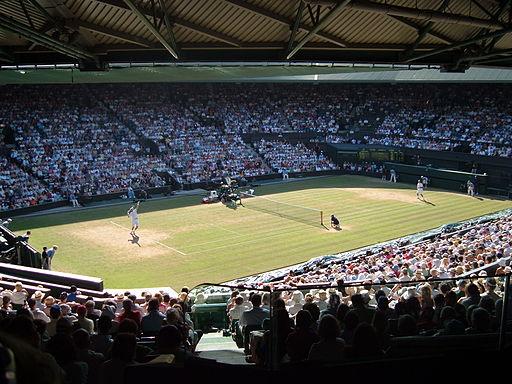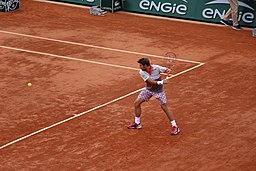1.Prologue
Both BigBrother and I have written about tennis before under SPORTS & CULTURE—what draws us to the sport, about choosing a racket, and other insights. This week I’d like to take a look at tennis wear, which is just as complex and interesting a tennis topic as gear and strategy.
2.Tennis Fashion Past and Present
The classic tennis outfit, of course, is polo shirt, tennis shorts (or tennis skirt), a headband and wristband. Since the birth of the sport, tennis has had a strong association with fashion.
Wimbledon, for example, has traditionally required all participants to wear all white. Tennis has its roots as a country club sport, and as such, a dress code has always played a part in the sport—whether you’re a player or a spectator.
The overlap between tennis fashion and modern trends of athleisure have only grown over time. In the 90s, many of the superstars of tennis wore clothes by Nike—and were not only functional but undeniably cool as well. Since the turn of the millenium, Adidas has expanded its roster of sponsored tennis players, Naomi Osaka among them. Meanwhile, Nishikori Kei and Roger Federer are sponsored by Uniqlo, which is also attempting to blur the line between sportswear and casualwear. Go to any tennis tournament around the world, and it’s clear fans are excited to see what their favorite players come onto court wearing.
Tennis fashion has become a part of our lives more than we realize. The brand Lacoste, for example, known for polo shirts emblazoned with their crocodile logo, was founded in 1933 by former French pro tennis player René Lacoste. Fred Perry, which started selling sweatbands in 1952 and is now known as a streetwear brand, is actually the namesake of a British former pro tennis player. And we cannot forget Adidas’ popular line of Stan Smith sneakers, undoubtedly one of the most commonly-sighted sneakers out there today. (I would expect that most people wearing Stan Smiths aren’t aware of the fact that the man was a tennis player. Although the shoes are now mostly for urban living, when they were first released they were used on clay courts.)
3.Tennis Players as Style Icons
As these brands demonstrate, tennis players are no strangers to being named style icons (and I’ve only listed a few male players above, but female fashion icons in tennis deserve a look of their own). Roger Federer, who’s been voted GQ magazine’s “Most Stylish Man”, is certainly at the top of that list. His partnership with Nike produced the iconic “RF” logo and years of successful tennis wear collections (*6). And Federer also counts among his admirers Vogue editor Anna Wintour (*7)—if that’s not a fashion endorsement, I don’t know what is. Incidentally, Wintour is known to play tennis every morning before heading into work.
Federer’s compatriot Stan Wawrinka is also a style icon of sorts, infamous for sporting so-uncool-its-cool kits on court. In 2015 he won the French Open wearing a pair of standout white and red checkered shorts; in his presser after his victory he placed his trophy on the table and laid out the shorts right next to it, and jokingly told reporters that “the shorts won the French Open." Then in 2016, he won the U.S. Open wearing a shocking pink outfit, which again became the talk of the town. At this point, the uncoolness of whatever he shows up on court wearing can surely be considered an indicator of just how far in the tournament he’ll go.
Watching Federer and Wawrinka in action is what led me to choose a single-handed backhand, as well as my weapons of choice—I use the rackets endorsed by the two players. I also look to these two greats for on-court fashion inspiration. In part two of this three-part article I’ll be featuring an outfit for hard courts and an outfit for omni-courts, as well as a detailed overview of the rackets and strings that I’ve been using. Personally, hard courts are my favorite surface, but in Japan most courts are omni-court (you‘ll be hard-pressed to find omni-courts anywhere else in the world), and so I’ll be going over considerations for both. There’s a lot to say in terms of style pointers, but to sum up my personal “dress code", it’s important to mix and match items from different brands. As I’ve written in this column in the past, if you show up on court wearing a shirt and pants from the same brand, my stylist Scarlet will inevitably ask, “When did you get that sponsorship deal?"
4.Epilogue: About the Four Types of Tennis Court Surfaces
In general terms there are four types of surfaces in tennis: grass, clay, hard court (usually cement or asphalt, sometimes coated in synthetic resin), and omni-court (synthetic grass with sand filling). Courts can also be indoor or outdoor, and some major facilities have a retractable roof.
・Grass courts are fast, with the ball tending to stay low to the ground—meaning that players have to “scoop" the ball up when they hit it. The most famous grass court tournament is Wimbledon.
・Clay courts are relatively slow, with prolonged rallies. This means that footwork becomes more important than sheer power. Clay courts are common throughout Europe.
・Hard courts can vary when it comes to speed and how the ball bounces—it all depends on the material. Most tennis courts in the U.S. are hard courts.
・Omni-courts are slow, and tend to dull the force behind shots. The surface is the most common one found in Japan—perhaps owing to the large amount of rainfall—and many critics point to its predominance as why Japan produces so few world-class players.












